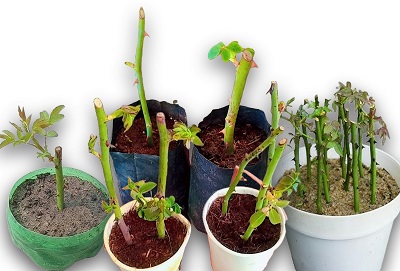Almost every other week, I receive calls from people asking if we sell rose seeds. While I could harvest seeds from my roses and sell them, doing so would be unfair to the client. Explaining why roses should not be propagated from seeds in a single phone call is nearly impossible. In this article, I will outline the challenges of growing roses from seeds and provide better alternatives for successful rose propagation.
Roses produce rosehips, which are the fruit of the rose plant and contain its seeds. Each type of rose has its own distinct hip shape and size, ranging from round to elongated forms. As the rosehips mature, their colour changes, typically turning vibrant shades of orange or red when fully ripe. While growing roses from seeds is possible, it is generally not the best way to propagate them. From the challenges of germination to the unpredictability of the resulting plants, seed propagation often fails to meet the needs of gardeners and hobbyists. Here’s why growing roses from seeds is problematic and alternative methods that are more effective.

Rose Hips from Different Types of Roses
Challenges of Seed Propagation
Many rose seeds are difficult to germinate, with some failing to sprout entirely. The outer coating of rose seeds can be hard and resistant, requiring extra steps to encourage germination.
Rose seeds often need stratification, a process of exposing seeds to a cold, moist environment to break dormancy. This can be tricky for gardeners to replicate at home and requires patience, as stratification may take several months.
Even experienced gardeners find rose seedlings prone to diseases like damping-off, a fungal infection that can quickly kill young plants. Maintaining the right balance of moisture and airflow is difficult and often results in losses.
Roses grown from seeds do not inherit all the characteristics of the parent plant. Like fruit trees, the offspring of roses are often inferior to their parent plants in terms of flower quality, colour, size, and fragrance. This unpredictability makes seed propagation an unreliable method for replicating desirable rose varieties.
Better Alternatives for Rose Propagation
Better alternatives for rose propagation include cuttings, grafting, and budding, which are faster and more reliable. These methods preserve the parent plant’s characteristics, ensuring consistent results and reducing the time needed for roses to flourish and yield pickable stems. It’s important to know your purpose for growing roses: are they for your garden or the cut flower market? Garden roses are best propagated from cuttings, while grafting or budding is a better choice for roses intended for cut flower production. Although another successful method is layering, it is not preferred because of its labor intensiveness and the limited number of plants that can be propagated from one mother plant.

Propagating Roses from Cuttings
Propagation by cuttings is one of the easiest and most accessible methods for home gardeners. Plants grown from cuttings are genetic replicas of the parent rose, ensuring that desirable traits such as flower quality and fragrance are preserved. Cuttings can be taken from different parts of the rose plant at various stages of maturity:

Softwood cuttings: Taken in late spring to early summer, these are the fastest and easiest to root.
Semi-hardwood cuttings: Collected in late summer to early autumn, they require slightly more time and care to establish.
Hardwood cuttings: Taken during late autumn or winter, these are the slowest and most challenging to root but are ideal for large-scale propagation.
Choose containers with enough drainage holes at the bottom to allow excess water to escape. It is crucial to keep the growing medium moist but not overly wet.
Steps for Propagating Roses from Cuttings
- Select a disease-free, well-hydrated rose bush with strong, green stems.
- Cut stems 15–25 cm long, about the width of a pencil, and include at least three leaf nodes. Because only 40% to 50% of rose cuttings root successfully, it is best to cut more stems than you actually need to ensure you get your desired quantity of rose plants.
- Remove lower leaves and leave one leaf at the top. Some growers advise to remove all the leaves completely.
- Use a pencil to make holes in your growing medium.
- Dip the base end of the cutting into powdered rooting hormone to encourage root growth.

- Carefully insert the cuttings into the pre-made holes, ensuring that about half of each cutting is buried in the soil. Press the soil gently around the stem and water thoroughly.
- Place the pot in a shaded area. Keep the soil moist but not wet. Too much moisture will cause root rot.
- Rooted cuttings need at least 6 months to develop strong roots before being planted in a garden.
Propagating Roses by Grafting or Budding
Grafting and budding are advanced propagation techniques used by nurseries. These methods combine the desirable traits of two rose plants. A cutting or bud-eye from a rose with superior flowers is grafted onto a rootstock with strong growth habits and disease resistance. The T-bud method is preferred for its efficiency and the ability to produce a high number of new plants from a single scion. The resulting plant benefits from the flower quality of the scion and the hardiness of the rootstock.

Advantages of Grafting
- Uniform Growth: Grafted roses tend to grow more uniformly than cutting-grown (own-root) plants
- Vigor: Grafted roses often demonstrate greater vigor due to the combination of a desired rose variety (scion) and a hardy rootstock. This results in earlier flowering and higher yields.
- Improved Qualities: Grafted roses inherit vigour, adaptability, winter hardiness, and disease resistance.
- Economic Efficiency: These plants are more economical to produce and perform better in terms of productivity than cuttings.
Choosing Rootstocks
- Only specific rose types are suitable as rootstocks. These are chosen for their:
- Ability to thrive in diverse soils and climates.
- Disease Resistance: Some rootstocks are selected for their resistance to specific diseases, which can benefit the grafted rose and contribute to more consistent growth.
- Ease of accepting grafts from superior flowering varieties.

Conclusion
While seed propagation may seem like a natural option, it often leads to disappointment due to germination challenges, disease risks, and the unpredictable nature of seed-grown roses. For home gardeners, propagating roses from cuttings is an easy and effective method that ensures plants retain the qualities of their parent. Meanwhile, grafting and budding are preferred for large-scale production, yielding superior plants that balance beauty with resilience. By choosing the right propagation method, gardeners can enjoy healthy, vibrant roses that thrive in their gardens.







